Ducks are as diverse as the wetlands they inhabit. From the wary pintail skimming over rice fields, to mallards filtering through flooded timber gaps, to scaup barreling into longlines, and the regal canvasback committing over open water, each species brings its own behaviors, habitat preferences, and migration patterns. Understanding these differences can make all the difference in the blind. This guide describes key species commonly pursued by waterfowl hunters and breaks down their habitat use and the hunting tactics best suited for success.
While each species has its quirks, many waterfowl hunting strategies overlap within functional groups—or guilds—like dabblers and divers. Tactics effective for one dabbler (e.g., gadwall or wigeon) often apply to others, just as diver duck setups frequently work across species like ringnecks, scaup, and redheads. Still, a deeper understanding of habitat use and seasonal duck behavior can help target specific birds more effectively.
The most important constants across all species are location, realism, and adaptability. Be where the birds want to be. Match your decoy spread to what you’ve scouted—consider not just the species composition but also posture and spacing (e.g., were birds bunched up, widely spaced, mostly feeding, or standing in shallow water?). Lastly, stay mobile. Being willing to move setups based on bird behavior, weather, or pressure can make the difference between a slow day and a limit.
Wood Duck

Often considered one of the most striking of all North American ducks, wood ducks are easily recognized by their iridescent plumage and distinctive crested heads.
They are also among the earliest migrators and breeders. In the Southeast, resident populations combine with migrating birds to make wood ducks one of the most abundant and heavily pursued species. As cavity nesters, they use natural tree cavities or artificial nest boxes for nesting. Wood ducks are also highly regarded at the dinner table. A fat, acorn-fed woodie can be one of the finest meals waterfowl has to offer.
Wood Duck Habitat
During spring and summer, wood ducks select forested wetlands, oxbows, and flooded bottomlands for nesting and brood rearing. As the season progresses, they shift to habitats with abundant food such as acorn-rich sloughs, moist soil wetlands, and beaver ponds. Their ideal environment is where shallow water meets woody cover. They are common throughout the Mississippi and Atlantic Flyways.
Wood Duck Hunting Tactics
Wood ducks are not especially responsive to calling, so success depends heavily on location, particularly near known roosts or flight corridors at first light. Wood ducks that have landed out of range can sometimes be attracted by whines from a drake wood duck call.
However, the most important factor is location. Setting up where they have been feeding or passing through with a small spread, just a few decoys on a jerk string or a spinning wing decoy, is often enough. Be ready at legal shooting light. Woodies come in fast, early, and often without warning.
Mallard
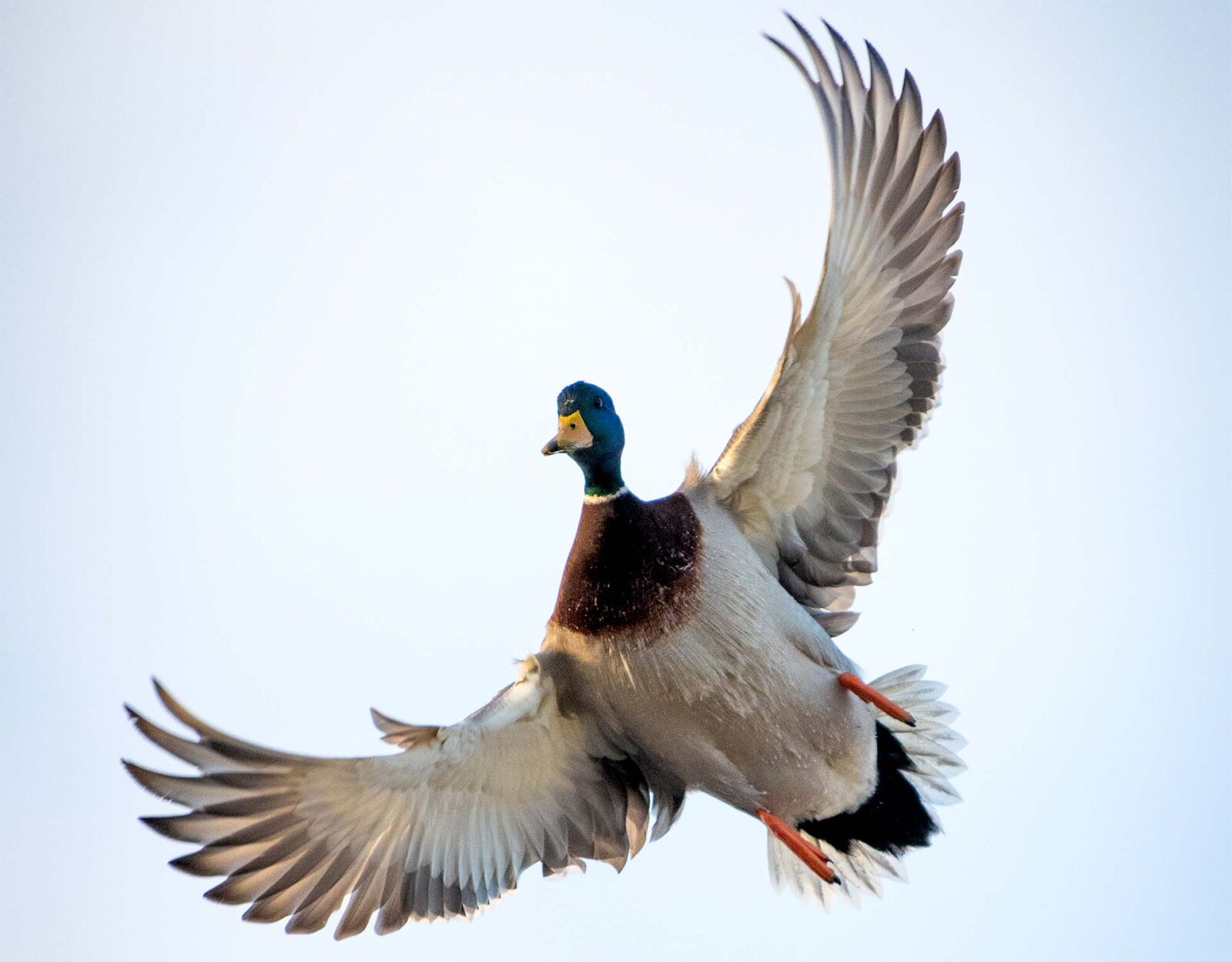
The quintessential duck. Mallards are large, vocal, and the cornerstone of many hunters’ seasons.
Biologists refer to mallards as “generalists,” meaning they are highly adaptable, opportunistic feeders, and aggressive competitors. Few species have adapted to our changing landscape as successfully as the mallard. They are the most widely distributed and most harvested duck in North America.
Mallard Habitat
Mallards occupy a wide range of wetlands from prairie potholes and flooded timber to agricultural fields, emergent marshes, and even urban wetlands. While present in all four flyways, they are especially abundant in the Mississippi and Central Flyways.
In winter, mallard habitat use shifts in response to weather and seasonal biological needs. During cold spells, they often concentrate on high-energy agricultural grains like corn and rice to offset increased energy demands associated with staying warm.
In late winter, as pair bonds solidify, they shift toward more secluded forested and scrub-shrub wetlands that offer isolation, thermal refuge, and abundant natural foods like acorns, tubers, and aquatic invertebrates. So, knowing when mallards will seek particular types of cover can help hunting success.
Mallard Hunting Tactics
Effective mallard hunting depends heavily on your location within the flyway and the seasonal biological needs of the birds. During migration, food is the primary driver of habitat, whether mallards are building reserves to continue south or replenishing energy lost along the way. Courtship behavior also begins during this period, with early signs of pair formation already visible.
In southern latitudes during early season, this emphasis on feeding continues. Focus your efforts on shallow flooded grain fields and, especially, moist-soil impoundments where natural foods like smartweed, sprangletop, and aquatic invertebrates are abundant. These habitats offer mallards a rich mix of nutrients and energy, critical for recovery and maintenance.
As winter progresses and temperatures drop, shift your hunts to grain fields or areas adjacent to secure roosts. Cold weather increases birds’ energetic demands, and they respond by targeting high-energy food sources like corn and rice.
In the late season, biological priorities shift toward pair bonding. Mallards begin seeking out more secluded scrub-shrub and forested wetlands that provide thermal refuge and isolation from other flocks—ideal conditions for strengthening pair bonds. Targeting these areas can be especially productive.
Throughout the season, hen mallard calls can be effective, but use restraint—especially later in the year when birds become increasingly wary and call-shy. Motion decoys that mimic feeding activity help bring realism to your spread.
In the final days of the season, consider the biology: many hens are paired, and lone drakes are still searching. Downsizing your spread and increasing the ratio of hen decoys can help draw in those unpaired males looking for late-season companionship.
Northern Pintail
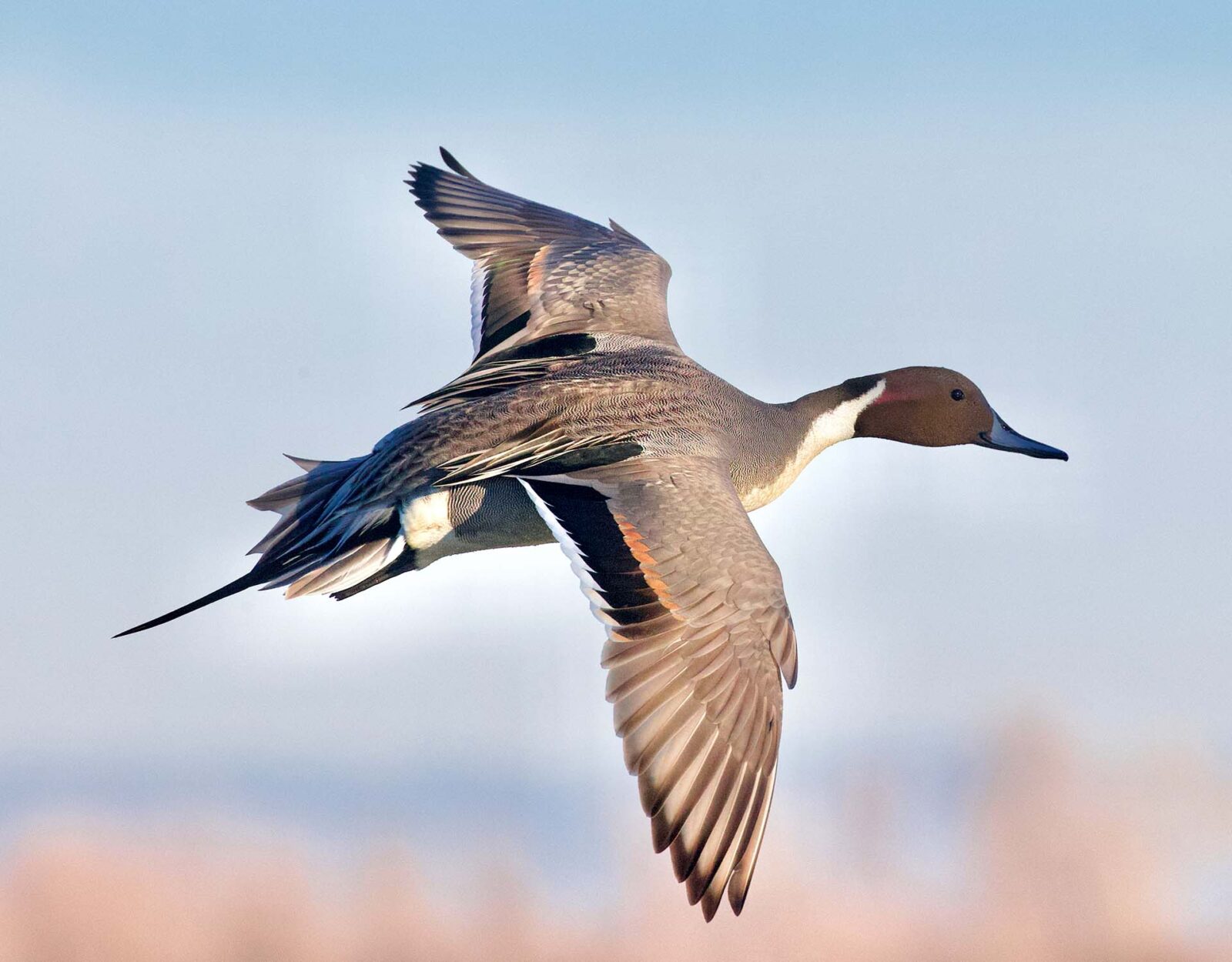
Northern pintails are sleek, fast-flying ducks admired for their long necks, pointed tails, and striking plumage.
They are among the earliest migrants each fall and are also some of the first ducks to begin pair bonding in winter. Pintails are highly sought after by hunters not only for their appearance but also for the challenge they present, often approaching cautiously and circling wide before committing. Of course, we all have those fortuitous days when you can’t keep them out of the decoys.
Northern Pintail Habitat
Pintails prefer shallow, open habitats where visibility is high and vegetation is sparse. During fall migration and early winter, they focus on flooded agricultural fields, especially rice and fallow grain, shallow moist soil impoundments, and open sheet water. Their diet during this time centers on small seeds and aquatic invertebrates, which fuel long-distance migration.
In southern latitudes, pintails continue using these shallow, open areas throughout the winter. As the season progresses and pair bonds strengthen, they often seek less disturbed wetlands that offer open water and security. These birds are sensitive to pressure and will quickly shift to alternative habitats if disturbed too frequently.
Northern Pintail Hunting Tactics
Pintails are wary and approach with caution, often flying high and circling multiple times before committing. Early in the season, focus on shallow rice fields and moist soil units with exposed mudflats, smartweed, or barnyard grass. Scouting is essential, as pintails tend to gather in large numbers on broad, shallow flats that may be overlooked by hunters targeting flooded timber or deeper wetlands.
Use a sparse decoy spread with wide spacing and clear landing zones. Avoid tight, cluttered spreads; pintails prefer open water and elbow room. Adding a few upright drake pintail decoys can help signal safety to high-flying birds. Incorporate motion using jerk cords or water motion decoys to add realism.
A pintail whistle can be effective when used sparingly, especially when mixed with light mallard calling. However, overcalling can flare cautious birds. In the late season, consider targeting loafing or staging areas during mid-morning, when birds break away from larger flocks to rest or court. These setups often require a low-impact approach and minimal disturbance for success.
American Wigeon
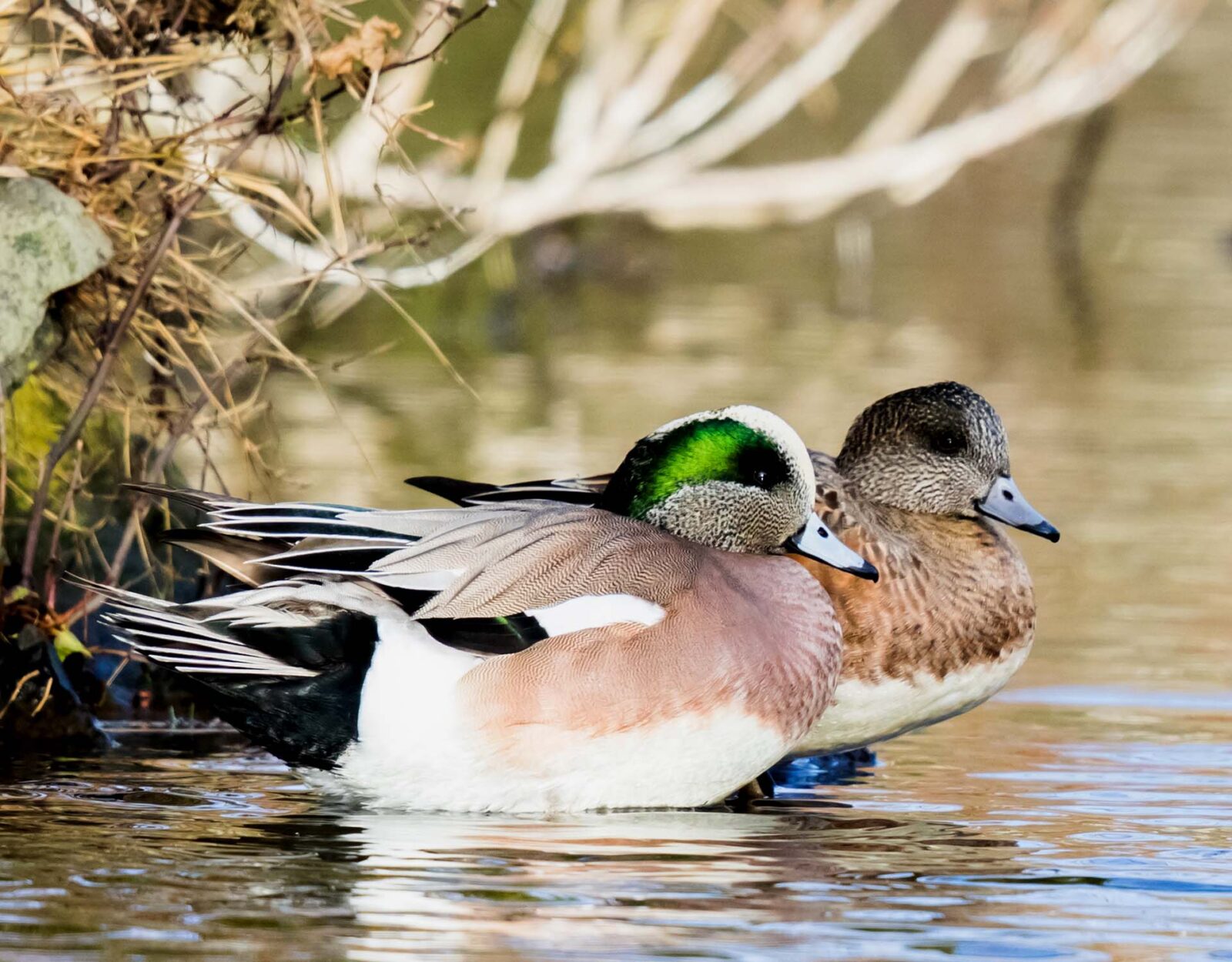
American wigeon are compact, fast-flying dabblers recognized by their round heads, pale beaks, and, in the case of drakes, the signature white crown or “baldpate.”
They are often vocal on the wing, giving off a distinctive whistling call, and are popular among hunters for both their flighty nature and table quality. Wigeon frequently associate with other dabblers and even diver flocks.
Wigeon Habitat
Wigeon prefer open, shallow wetlands with good visibility and abundant food. Early in the migration, they concentrate in moist soil impoundments, shallow flooded pastures, and open marshes where they forage heavily on seeds and aquatic invertebrates. Unlike many dabblers, wigeon frequently graze on upland vegetation like clover or winter wheat and are known to feed on submerged aquatic vegetation (SAV) such as pondweed and coontail when available.
They also exhibit a unique foraging behavior biologists call kleptoparasitism, often stealing vegetation from coots and other waterfowl. As the season progresses and pair bonds begin to form, wigeon often shift to quieter loafing areas or less pressured feeding sites.
Wigeon Hunting Tactics
Wigeon often decoy well and are highly responsive to vocalizations, especially their characteristic high-pitched three-tone whistle. A few dedicated wigeon decoys mixed into a standard dabbling duck spread can help, but more important is setting up in habitat they are actively using—wide open flats, moist soil units, or pasture sloughs with exposed mud and early successional growth.
Motion is important. Jerk rigs, water motion decoys, or low-profile spinning wing decoys can help replicate foraging activity. Calling should include soft mallard chatter and intermittent wigeon whistles to create a natural, social atmosphere.
Because they often arrive in flocks, be prepared for fast-paced shooting when they commit. In pressured areas or late in the season, scale back your calling and reduce decoy density. Loafing birds looking to rest with small groups may shy away from large, noisy spreads. As with pintails, positioning and concealment in open areas are key to drawing wary wigeon into range.
Teal Ducks (Blue-Winged and Green-Winged)
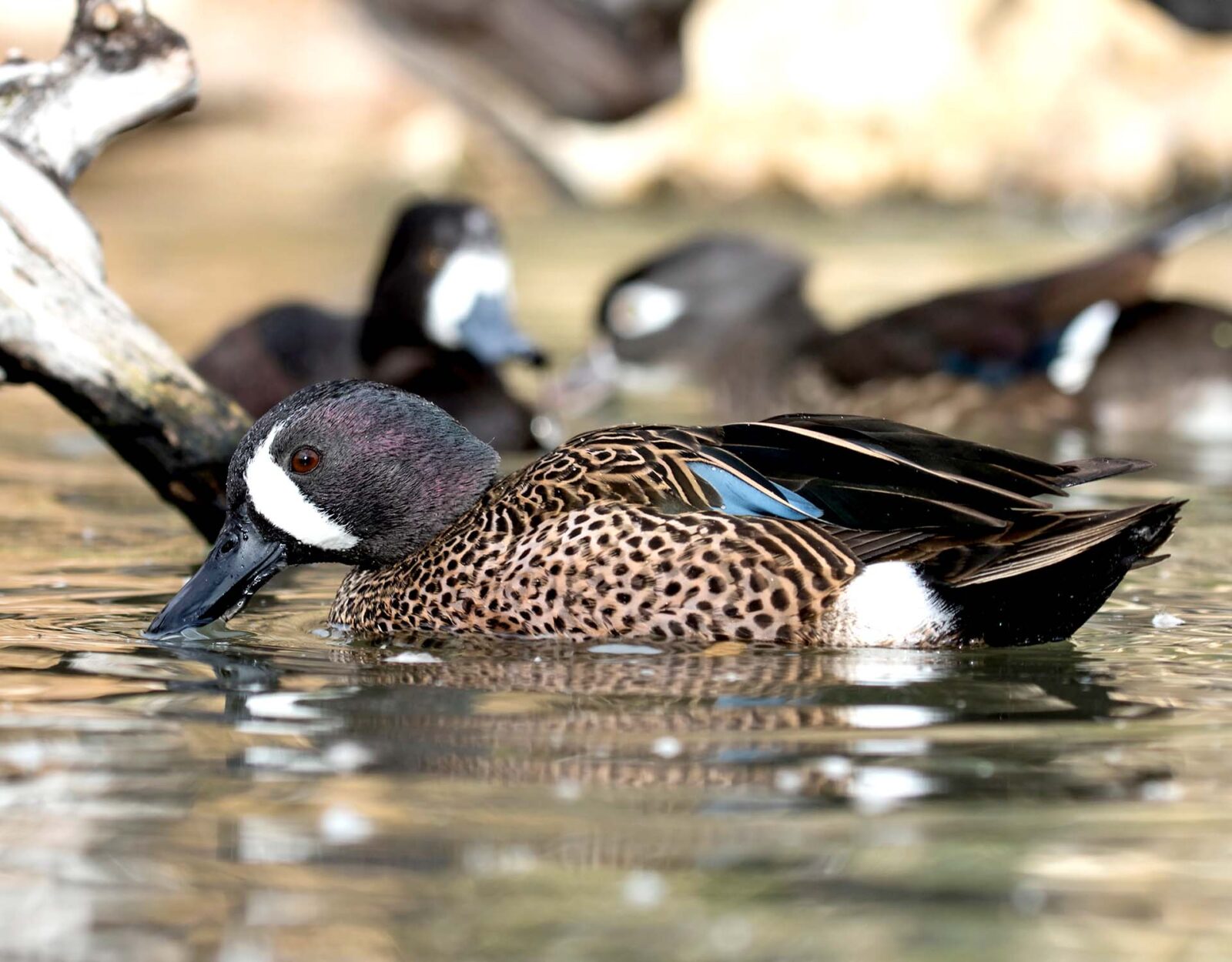
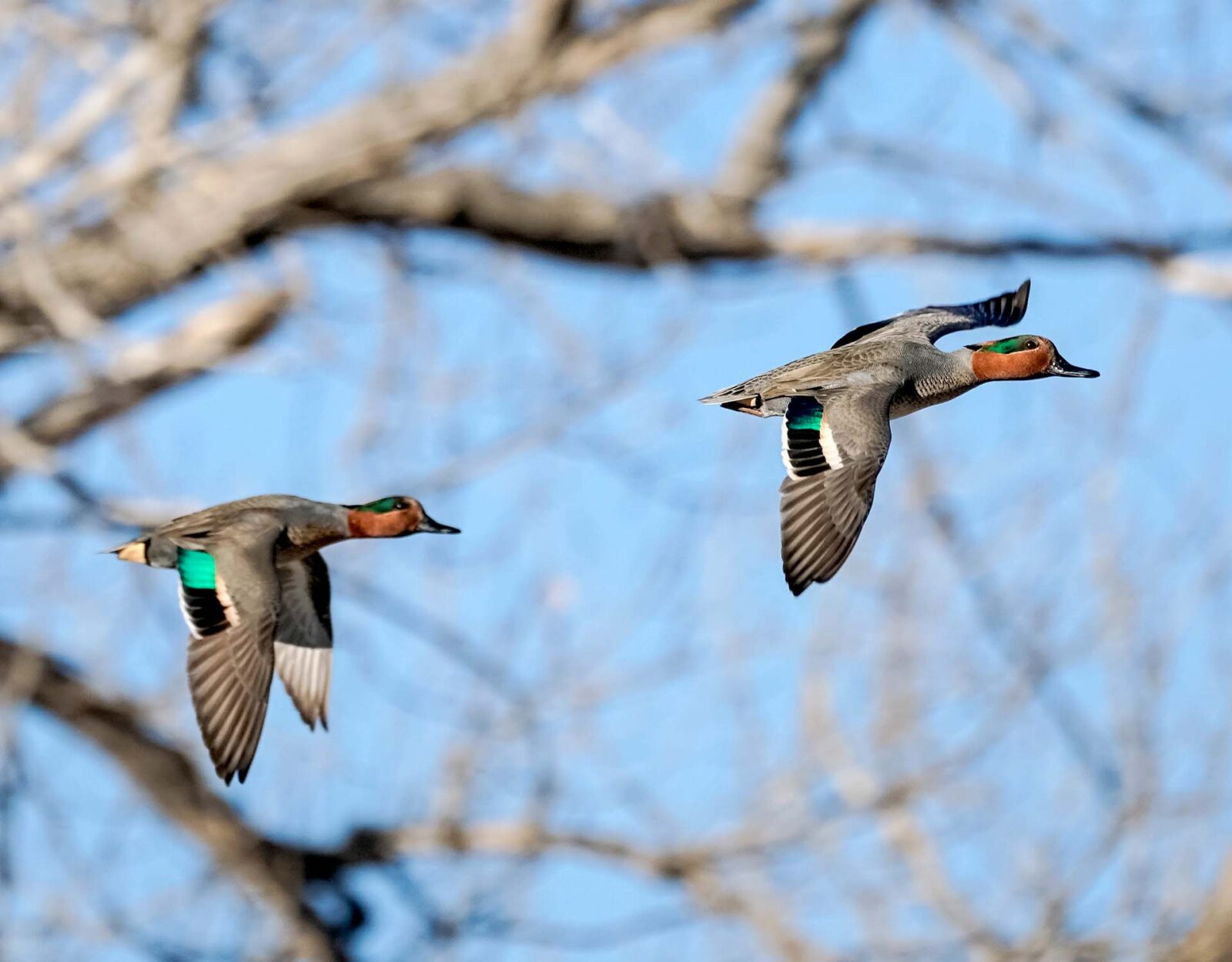
Teal are small, fast-flying ducks that offer some of the most exciting and accessible hunting opportunities across North America. While both blue-winged and green-winged teal are commonly harvested, they differ significantly in migration timing, habitat use, and behavior.
Blue-winged teal are early migrants and tropical winterers, often gone from northern latitudes before the regular duck season begins. Ecologically, they are more similar to northern shovelers than green-winged teal, favoring warm climates, feeding heavily on aquatic invertebrates, and using shallow wetlands with dense vegetation. Their early movements are driven by a need to avoid cold weather and maintain access to soft-bodied prey.
Green-winged teal, on the other hand, are more cold-tolerant and flexible. They migrate later and often remain through the end of the season in southern latitudes. They can use a broader range of wetland types, including deeper emergent marshes, flooded fields, and even sewage lagoons, adapting their diet seasonally to include both seeds and aquatic invertebrates.
Teal Duck Habitat
Blue-winged teal prefer shallow water, including ankle-deep sloughs, moist soil units, and early-flooded agricultural fields where food is abundant and water temperatures remain warm. They key in on areas rich in invertebrates like midge larvae, snails, and aquatic insects, especially during late summer and early fall migrations.
Green-winged teal use similar shallow habitats but are far more adaptable later in the season. They forage in flooded fields, moist soil impoundments, scrub shrub wetlands, and roost in deeper open water. Their small body size and rapid metabolism keep them actively foraging throughout winter, particularly on small seeds such as barnyardgrass and sprangletop.
Teal Duck Hunting Tactics
Early season teal hunts are best centered on shallow, muddy margins and recently flooded wetlands. Shallow water is key, but they can be found in deeper water when the landscape is relatively dry. Blue-wings decoy aggressively and respond well to spinning wing decoys and realistic movement on the water. Use a small, tightly clustered decoy spread consisting of half a dozen teal decoys, a jerk string, and one or two spinners—often all you need.
Minimal calling is recommended for blue-wings. A sharp, raspy hen descrescendo or an occasional peep can help, but location and motion are more important. Focus on wetlands with active insect life and fresh plant growth from early drawdowns or managed flooding.
Green-winged teal become the dominant teal species as fall progresses. They are more tolerant of cold and pressure and will decoy reliably into mixed-species spreads. They often fly fast, low, and erratically, so be ready—they can appear suddenly and buzz the decoys without circling.
In the late season, consider downscaling your spread and calling less aggressively, as you would for most species. A few teal decoys and subtle motion can still pull in small flocks, especially on overcast days when other ducks are wary.
Northern Shoveler
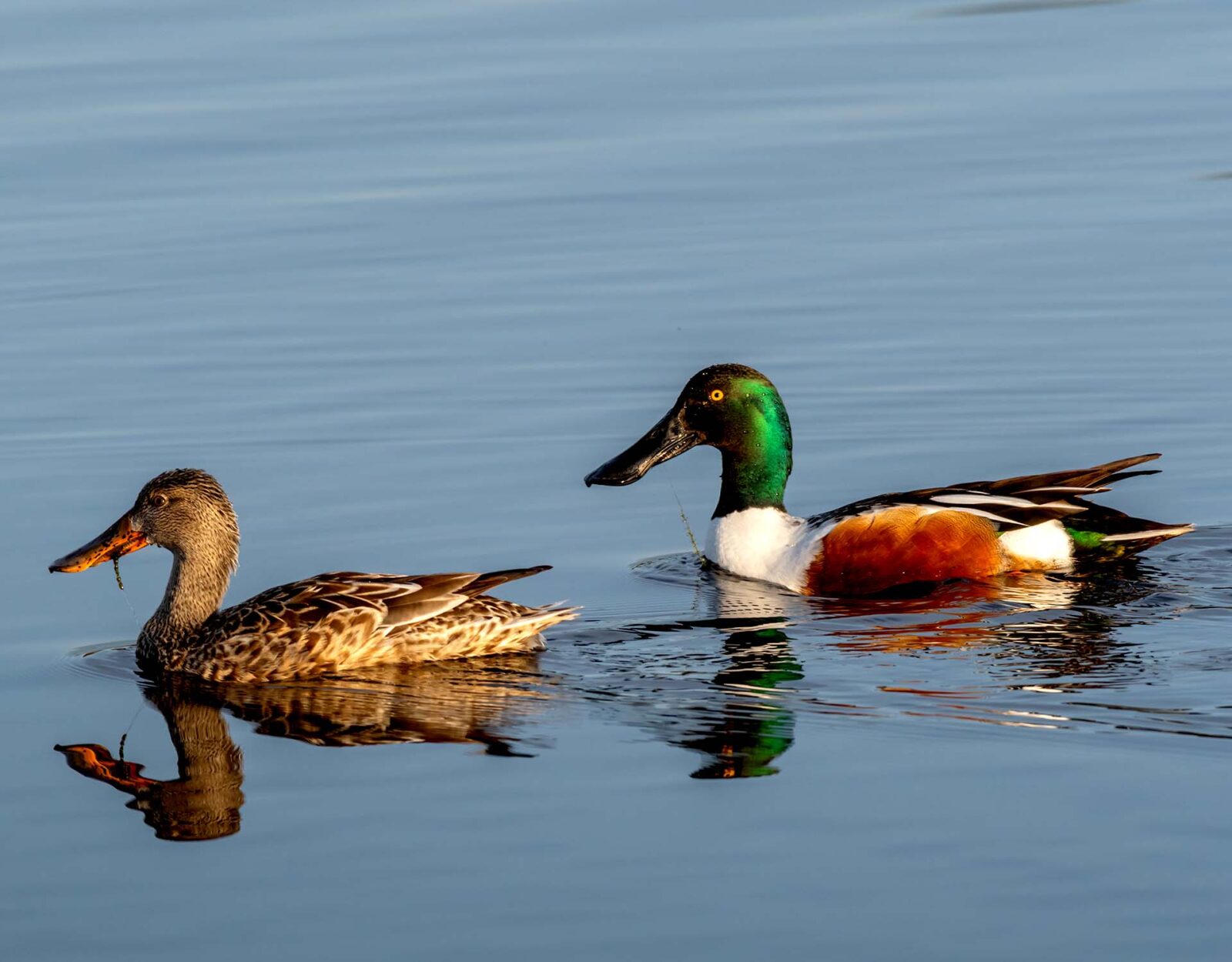
Northern shovelers are instantly recognizable by their oversized, spoon-shaped bills, which they use to filter tiny aquatic organisms from the water.
Sometimes called “spoonies,” shovelers are dabblers with feeding behaviors more similar to blue-winged teal than mallards or gadwall. That broad bill isn’t just for show—it is highly specialized for sifting plankton, seeds, and aquatic invertebrates from shallow water. Shovelers often gather in groups and forage in a circular pattern to stir up food items in the water column. They are social birds, commonly found in large, dense flocks, and while sometimes overlooked by hunters, they are abundant, widespread, and can make for fast-paced hunting when patterned well.
Shoveler Habitat
Shovelers prefer shallow wetlands with high invertebrate biomass and low water clarity, conditions that support their filter-feeding style. They use moist soil units, flooded fields, temporary wetlands, aquaculture ponds, and wastewater treatment cells, especially those rich in algae and plankton.
In early fall and during migration, shovelers concentrate in wetlands that experienced summer drawdowns and have since reflooded, producing high densities of aquatic invertebrates. Their habitat use is often more closely tied to the productivity of the wetland than to the specific wetland type. Where invertebrate abundance is high, shovelers will be present—whether in a natural basin, a managed impoundment, or an aquaculture pond.
Shoveler Hunting Tactics
Shovelers decoy readily, especially early in the season. Their large flocks and confidence in open, shallow water make them relatively easy to work if you are set up where they want to be. Motion decoys work well for shoveler. Spinning wing decoys, feeding motion decoys, and jerk cords all help replicate natural feeding activity.
Because shovelers often feed by swimming in tight circles with their heads down, consider clustering your decoys more closely than you would for mallards or pintails. You can even imitate this behavior with a jerk string, or a small circular decoy spread to suggest active feeding.
Calling is rarely necessary, but a few soft quacks or social chatter from gadwall or wigeon calls can enhance realism in mixed-species spreads. If they make a single pass and start to land elsewhere, an aggressive mallard decrescendo can sometimes pull them back around to your spread.
In the late season, shovelers often concentrate in nutrient-rich water bodies with minimal disturbance. They may raft in the middle of impoundments, aquaculture ponds, or treatment cells and make short flights between feeding and loafing areas. As always, concealment is critical. Shovelers may not be all that wary, but they will flare from unnatural movement or shiny blinds.
Gadwall
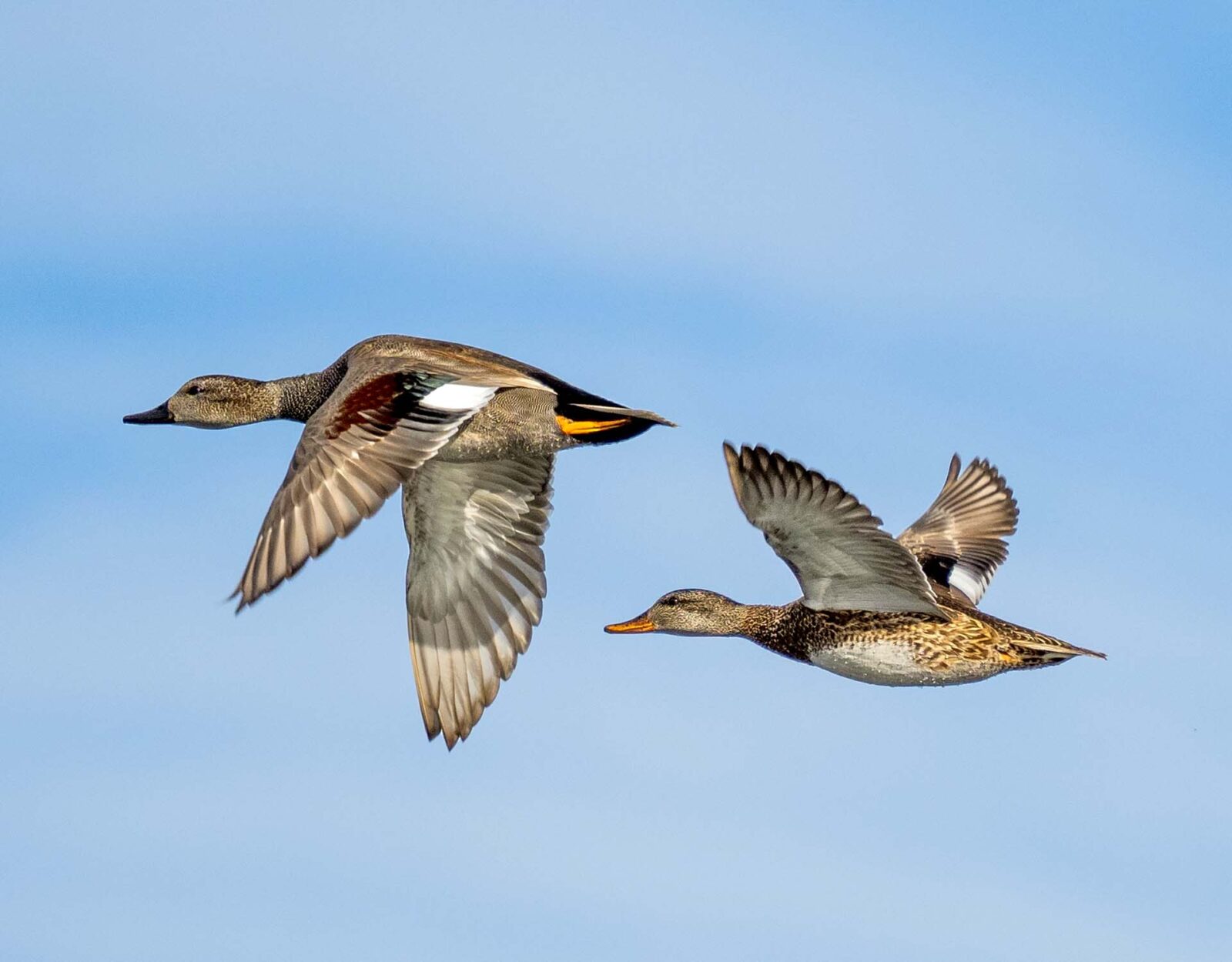
Often referred to as “gray ducks,” gadwall may look plain at a glance, but they are one of the most abundant and heavily harvested dabbling ducks in the Mississippi Flyway, and with good reason. Their understated plumage conceals a tough, adaptable bird that thrives in a variety of wetland habitats.
While not flashy, gadwalls are strong fliers, cautious in pressured areas, and responsive to realistic decoy setups. They also tend to decoy better and more consistently than most dabblers late in the season, especially where natural wetlands are available.
Gadwall Habitat
Gadwalls strongly prefer wetlands rich in submerged aquatic vegetation (SAV) and aquatic invertebrates, making them more vegetation-focused than most dabblers. They frequent moist soil impoundments, flooded pastures, shallow marshes, oxbow lakes, and forested sloughs, but show a strong association with clear water and robust SAV beds, often dominated by pondweed, coontail, or southern naiad. They will also feed in flooded croplands.
As winter progresses and pair bonds begin to form, gadwalls may shift slightly toward quieter loafing areas with good visibility, often remaining in shallow water with patchy vegetation where they can continue to forage and rest in relative isolation.
Gadwall Hunting Tactics
Gadwalls typically respond best to low-pressure wetlands with natural food and subtle decoy setups. A natural-looking decoy presentation with a mix of gadwall, mallard, and other dabbler decoys is often most effective. As with most other species, some motion adds to realism. Water motion decoys or jerk strings provide just enough movement to encourage birds to finish.
A few soft hen quacks or even quiet wigeon whistles can help give your spread a natural, relaxed soundscape. Focus on concealment, especially in sparse cover. Gadwalls may decoy well, but they will flare quickly if blinds are poorly brushed or if hunters stand up too early.
Late in the season, gadwalls can become some of the most consistent birds in the bag if you find the right mix of cover and food. Target shallow, clear wetlands with SAV or low-growing emergent plants, and hunt with a minimalist mindset: less calling, less gear, more realism.
American Black Duck
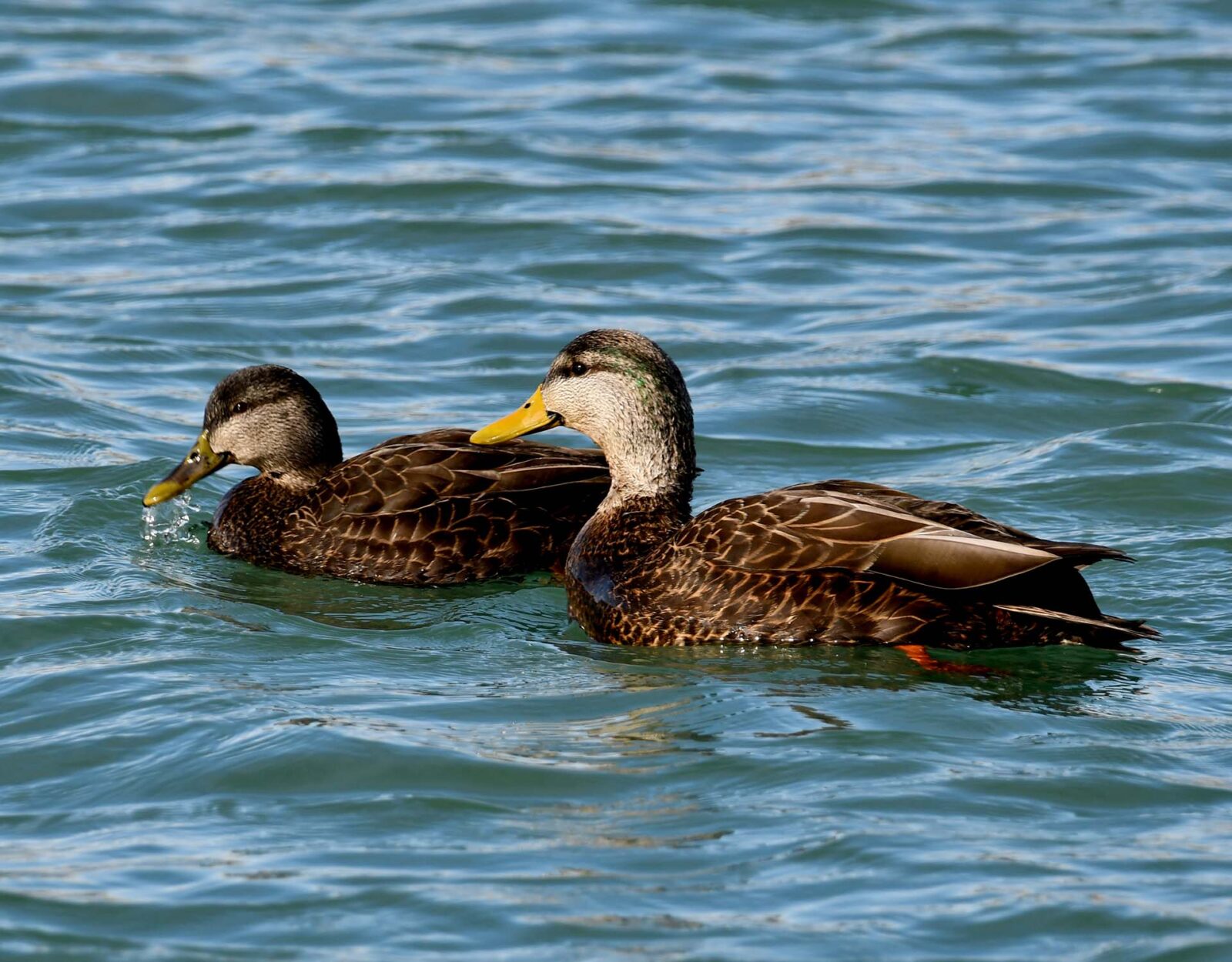
American black ducks are often described as the eastern counterpart to the mallard, but they are a distinct and iconic species in their own right. While they are genetically similar to mallards, they differ in several important ways.
With their dark chocolate bodies, pale faces, and striking contrast against lighter water or snow, black ducks are unmistakable in flight. They are also known for being fairly challenging to decoy, especially in late-season conditions.
Once widespread throughout the Atlantic Flyway and Eastern Mississippi Flyway, black duck populations declined in the mid-20th century due to habitat loss and hybridization with mallards. As mallards have expanded eastward, they have displaced black ducks from much of their former range. Today, black ducks are much rarer in the southern Mississippi Flyway states.
Black Duck Habitat
Black ducks favor secluded wetlands and coastal systems, especially brackish and tidal marshes, estuarine bays, and backwater sloughs with minimal disturbance. They also use forested wetlands, beaver ponds, and scrub shrub swamps, particularly in the interior portions of their range. During migration and winter, they seek areas that provide both security and access to submerged vegetation, seeds, and invertebrates.
They are highly sensitive to hunting pressure and human activity, often shifting their patterns in response to disturbance. In coastal systems, black ducks retreat to remote tidal creeks or salt marshes during the day, feeding and moving more at night. In inland areas, they gravitate toward wooded or shrubby wetlands that offer concealment and solitude, especially as pair bonding begins later in winter.
Black Duck Hunting Tactics
Hunting black ducks successfully demands patience, discretion, and a low-impact approach. These birds flare easily and often hang high or skirt the edge of decoy spreads. Effective tactics include hunting remote or lightly pressured areas, especially those with forested or brushy edges and soft transitions from cover to open water.
Use a minimalist decoy spread. Dark-bodied black duck decoys or hen mallards with reduced white contrast work best. Space decoys naturally and leave a clear landing pocket to help wary birds commit. In tidal areas, hunt the edge of shallow creeks or salt pans where birds loaf during mid-morning and early afternoon.
Calling should be minimal. Soft quacks or social feeding chatter may help finish birds already working the spread, but aggressive calling is more likely to push them away. The most critical elements are concealment and stillness. Blinds should be fully brushed in, low profile, and located in areas birds naturally use.
In the late season, when most hens are paired, focus on unpaired drakes looking for company. A small spread of black ducks and subtle motion may be enough to tempt these lone birds. If hunting in coastal zones, watch the tides closely. Some of the best hunting occurs during a falling tide when birds return to feed on exposed flats and mud edges.
Redhead Duck
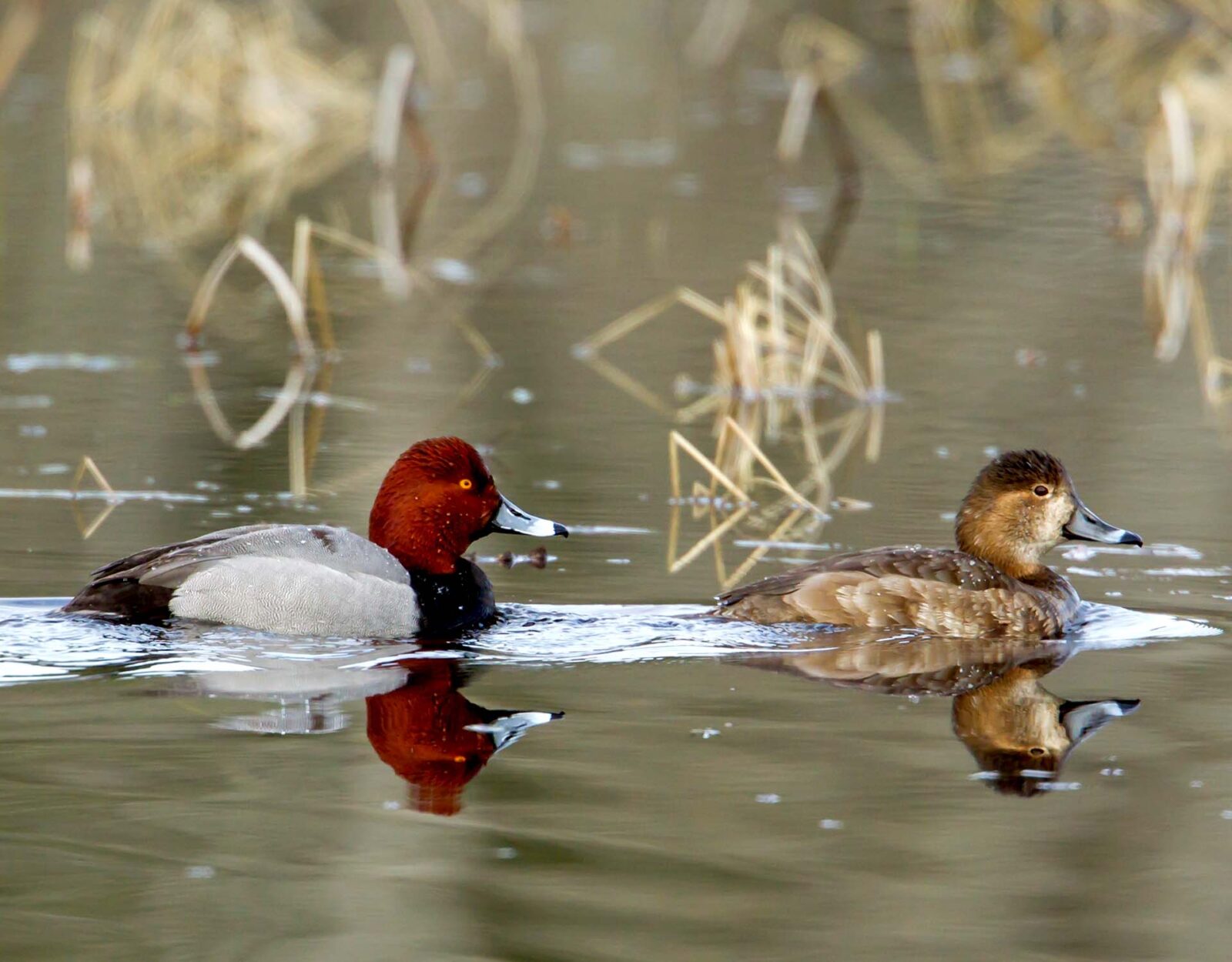
Redheads are striking diving ducks known for their chestnut-red heads, gray backs, and swift flight. They often fly in tight flocks and can decoy boldly into open-water spreads, making them a favorite among diver hunters.
Redheads breed across the Prairie Pothole Region, and significant numbers stage and winter in the Central and Mississippi Flyways, especially along the Gulf Coast.
Redhead Duck Habitat
Redheads are highly reliant on large, open wetlands rich in submerged aquatic vegetation (SAV). In early fall, staging birds in the northern portions of the flyway feed heavily on sago pondweed, wild celery, and other SAV species that provide both energy and nutrients needed for migration. As winter progresses, they increasingly use large freshwater lakes, coastal bays, and deeper marshes where they form dense rafts, often alongside scaup, canvasbacks, and ring-necked ducks.
While redheads can occasionally be seen using flooded agricultural fields or shallower emergent wetlands, they are most consistently found in clear, deeper water systems that support high SAV biomass.
Redhead Duck Hunting Tactics
Hunting redheads successfully depends on identifying key feeding and loafing areas during different phases of the season. In early to mid-season, birds are primarily focused on foraging to support continued migration. Scout for open water with abundant vegetation and good visibility. In southern latitudes or coastal systems where redheads overwinter, they often raft in large numbers on coastal lakes and sounds, at times moving inland or to shallower waters to feed.
Depending on the location, setting a generous number of decoys, particularly in larger bodies of water, can be effective. Longlines of diver decoys such as redheads, canvasbacks, bluebills, and even a few coots can help draw birds into range. Keep your lines neat and spaced to simulate relaxed birds. Leave a landing zone or open pocket within the spread to give incoming ducks a clear place to finish. Use wind direction and boat position to funnel birds over your decoy hole.
Layout boats or low-profile blinds positioned along points or natural bottlenecks are particularly effective in open water. While calling is not a major factor for redheads, using a diver call or rolling your tongue while blowing into a mallard call to mimic the growls of divers can help add realism. Location, visible decoy spreads, and motion are key.
Canvasback
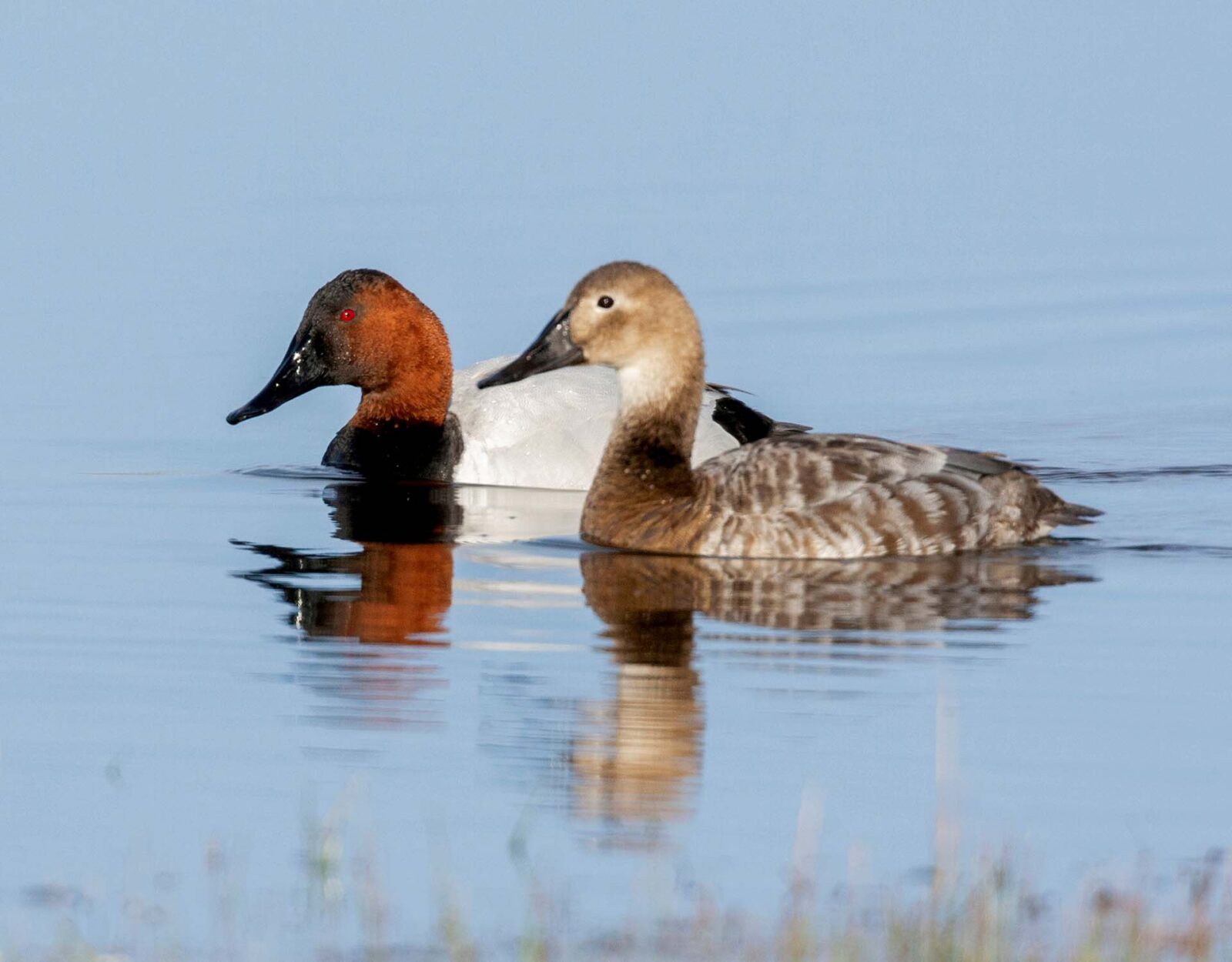
The canvasback is widely known as the “king of ducks,” a title earned by its size, speed, striking appearance, and historical value as one of North America’s most iconic waterfowl species. Drakes are unmistakable, with their chestnut-red head, long sloping black bill, black chest, and white back that gleams over open water.
Coveted by hunters since the market hunting days, canvasbacks were once among the most prized ducks served in fine dining establishments, particularly those sourcing from the Chesapeake Bay, where canvasbacks fed on vast beds of wild celery that gave their meat a renowned flavor and status.
Although much of that historical habitat has declined, canvasbacks remain a highly sought-after species and are still associated with large open-water systems, particularly in the Mississippi River corridor, the Upper Midwest, and along the Gulf Coast.
Canvasback Habitat
Canvasbacks are specialist divers that strongly favor deep, open wetlands with abundant submerged aquatic vegetation (SAV), especially sago pondweed, wild celery, and similar rooted aquatic plants. These foods are essential for meeting their high energetic demands during long migrations and cold winters. Unlike more generalist divers such as redheads, canvasbacks are less flexible in habitat choice—they require quality SAV-rich waters for staging and overwintering.
In the Mississippi Flyway, they concentrate on large oxbow lakes, floodplain reservoirs, and coastal bays. On rare occasions, they may use flooded agricultural fields or moist-soil wetlands, but typically only when water is deep, open, and undisturbed. They will frequently use the deeper portions of semi-permanent emergent wetlands. In late winter, they raft in large flocks far offshore, commuting to key feeding areas with minimal exposure to disturbance.
Canvasback Hunting Tactics
Hunting canvasbacks requires a commitment to open-water systems and visual decoy strategies. Large longlines of canvasback decoys with high visibility, especially white-backed drakes, are essential. Include redheads, scaup, and a few coots for realism.
Layout boats, low-profile blinds, or points with natural cover are ideal. Avoid sky-lining or standing vegetation that might silhouette hunters against the horizon. Canvasbacks don’t appear to respond all that much to calling, so focus on decoy realism, motion, and location. Wind-powered or battery-powered movement can help add life to your spread in calm waters.
In late winter, birds often form large rafts on open water, feeding and resting communally. Focus on the fringes of these rafts or travel corridors between known loafing and feeding areas. The best opportunities often come when small flocks peel off the main group to explore quieter areas mid-morning.
Scaup (Greater and Lesser)
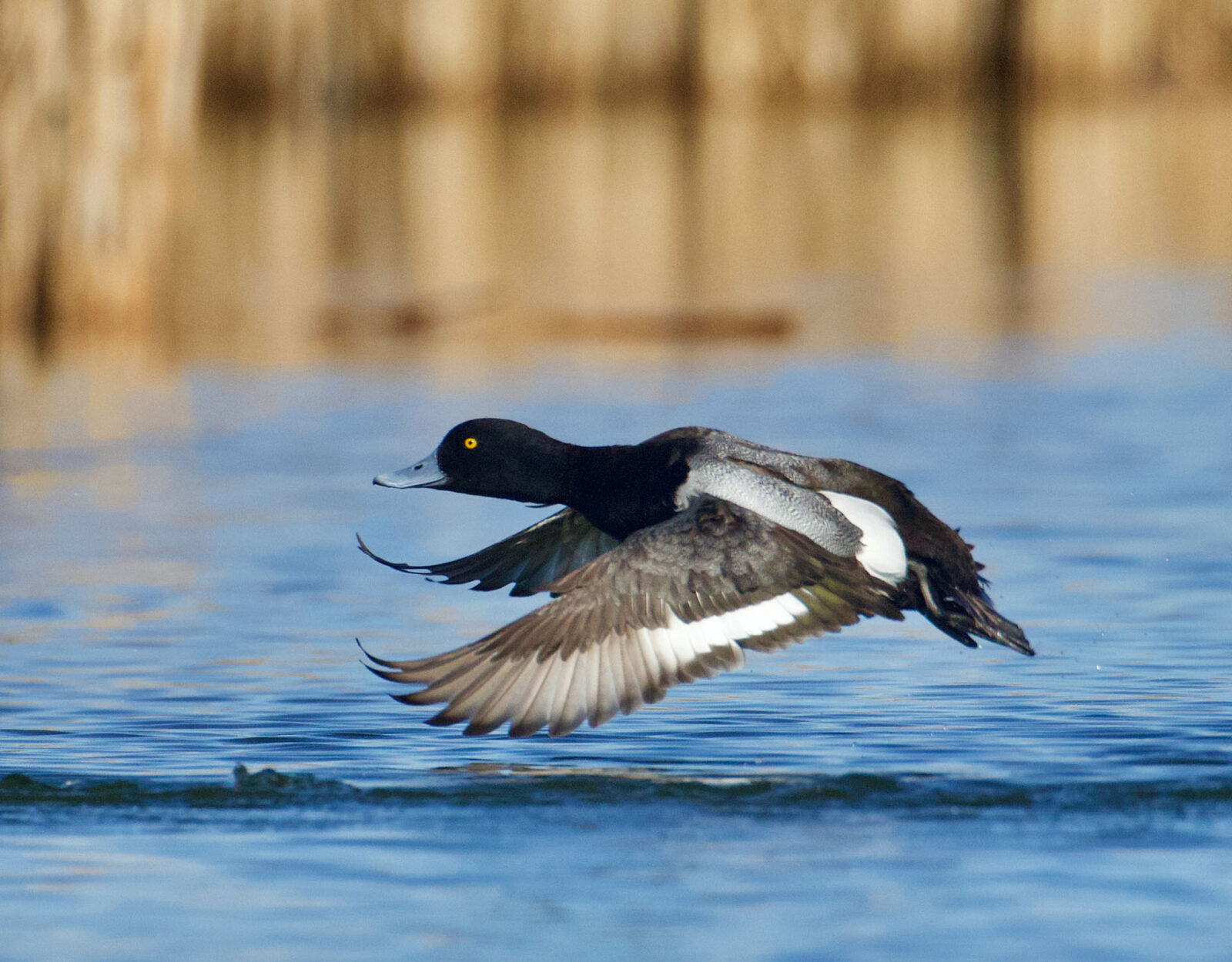
Scaup, commonly referred to as “bluebills,” are among the most heavily harvested diving ducks in North America and are a staple of diver duck hunting—the mallard of the diver world, if you will.
The group includes two species: lesser scaup, which are far more numerous and widespread, and greater scaup, which are typically more coastal in distribution. Both are known for their fast, direct flight, large flocks, and willingness to decoy when conditions are right.
Despite their abundance in the bag, scaup populations—especially lesser scaup—have experienced a long-term continental decline since the 1980s. While numbers have stabilized somewhat in recent years, they remain well below the long-term goals outlined in the North American Waterfowl Management Plan. The cause is likely multi-factorial, including reduced breeding success in the boreal forest, wetland degradation and loss, and changes in food quality on staging and wintering grounds.
Scaup Habitat
Scaup prefer open water habitats, often deeper than those used by dabblers or even some other divers. During migration and winter, they use large lakes, reservoirs, coastal bays, and managed impoundments with abundant submerged aquatic vegetation (SAV) and benthic invertebrates, especially mollusks.
In the Deep South, lesser scaup make extensive use of catfish aquaculture ponds, particularly in the Mississippi Delta. These ponds offer consistent water depth, minimal disturbance, and abundant food, including snails, insect larvae, and residual feed. Surveys in Mississippi and Arkansas have documented high concentrations of wintering scaup on commercial aquaculture facilities, especially during peak migration and periods of cold weather.
Greater vs. Lesser Scaup:
Greater scaup are generally larger and favor coastal and Great Lakes habitats in winter, where they feed primarily on mussels, clams, and marine invertebrates. Lesser scaup are much more widespread and adaptable, occupying a range of freshwater inland systems including managed reservoirs, oxbows, fish hatcheries, and aquaculture ponds. Their diet includes a broader mix of invertebrates, plant matter, and SAV.
Scaup Hunting Tactics
Scaup often respond well to large, high-visibility decoy spreads, particularly when hunting open water. Longlines of bluebill decoys mixed with canvasbacks, redheads, and coots can help simulate the dense rafts they naturally associate with. Be sure to leave a prominent landing pocket and position your blind or boat to take advantage of prevailing wind and sun angles.
In regions like the Lower Mississippi Valley, targeting aquaculture ponds can be highly effective, especially in colder periods when natural wetlands are frozen or food is scarce. Scout a complex of ponds and find where the birds are concentrated. Set up decoy spreads of scaup, shoveler, and coot decoys, and use layout blinds or hide along steep banks for concealment.
While calling is not essential, subtle diver-specific grunts or short feeding chuckles may help finish close birds. Motion on the water adds realism, especially in calm conditions.
Scaup are fast flyers and often make low, high-speed passes across spreads. Shooting opportunities can be sudden, and quick reflexes are key. In late winter, they may raft far from shore on large water bodies or concentrate in ice-free pockets, so scouting is essential.
Ring-Necked Duck
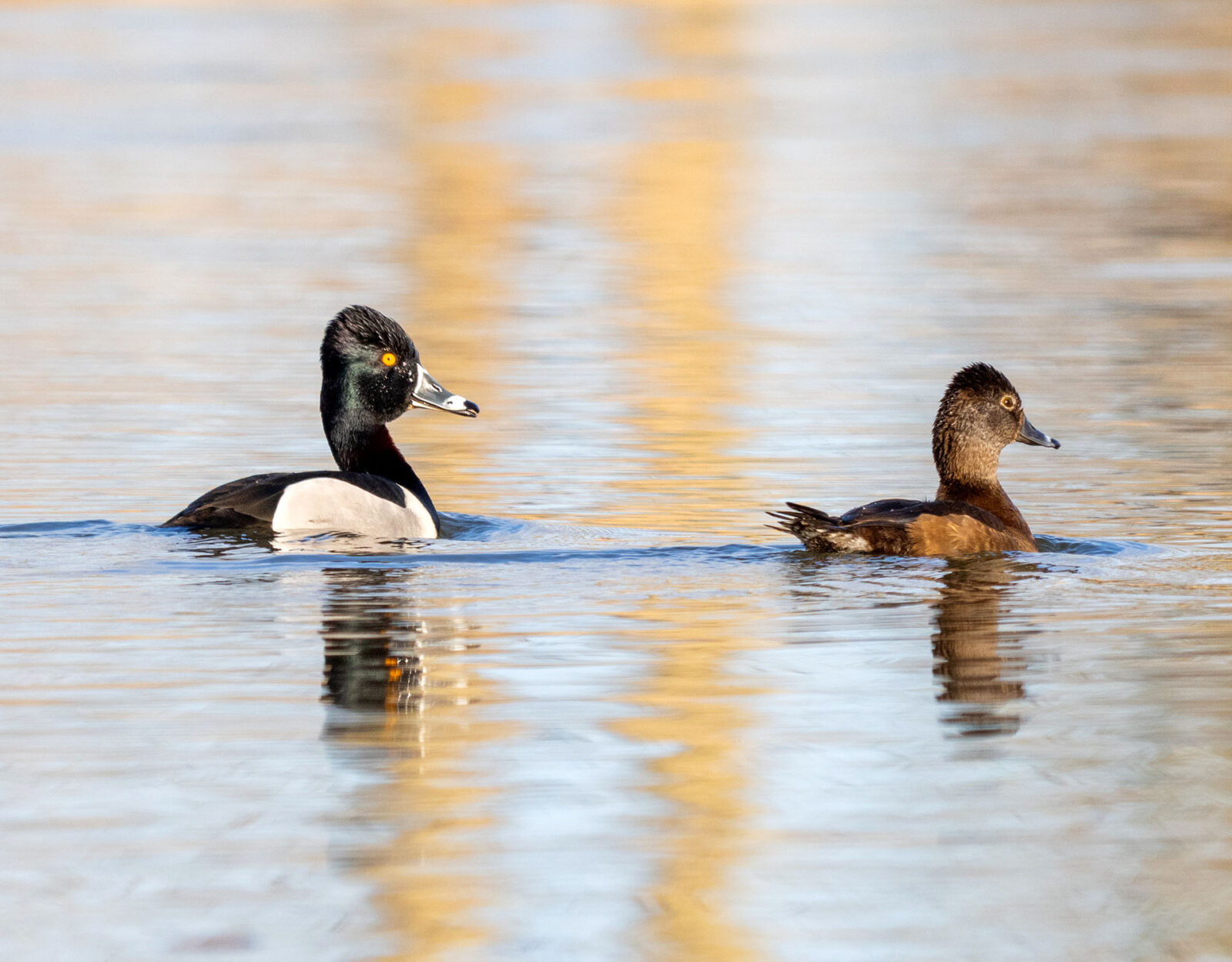
Despite their name, the subtle chestnut ring around a ring-necked duck’s neck is rarely visible in the field. Instead, hunters recognize them by their bold white bill ring, peaked head, and compact, athletic flight.
Ringnecks are medium-sized diving ducks, but much of their behavior resembles dabblers. They are widely distributed across North America and particularly abundant throughout the southeastern U.S. during winter. Agile and fast-flying, they are a favorite among hunters who know where to find them.
Ring-Necked Duck Habitat
Ring-necked ducks are highly adaptable and use a broad range of freshwater habitats. While classified as divers, they often occupy small wetlands, oxbows, forested sloughs, beaver ponds, and moist soil impoundments—many of the same areas favored by gadwalls and wood ducks. They also use deeper open water when needed, but their feeding behavior keeps them closer to the edge.
Their diet reflects this flexibility. Ringnecks feed heavily on submerged aquatic vegetation (SAV), seeds from moist soil plants, aquatic invertebrates, and agricultural grains when available. In this sense, they function as “pelagic dabblers,” working open water habitats but foraging like puddle ducks.
In northern breeding and migration staging areas—particularly across the Great Lakes region, the Upper Midwest, and parts of Canada—ring-necked ducks show a strong seasonal attachment to wild rice (Zizania spp.). These shallow, vegetated lakes and wetlands provide a rich food base during fall migration. Wild rice is a highly preferred seed and offers a critical energy source for staging birds building reserves for the long flight south. Many traditional ringneck strongholds, such as those in Minnesota and Wisconsin, are centered around wild rice lakes.
Ring-Necked Duck Hunting Tactics
Ringnecks often decoy well, especially when they are using smaller, undisturbed wetlands. In the South, they are commonly found in cypress-tupelo sloughs, oxbow lakes, semi-permanent emergent wetlands, and moist soil impoundments with good cover and food availability. They may also use public or private reservoirs and catfish ponds, particularly when shallow vegetated zones are present.
A productive approach is to add some ringneck decoys to your dabbler spread and place them in pockets along points or vegetated edges. Use jerk cords or motion decoys to create water movement. While not known for vocalizations, ringnecks may respond to soft social chatter or general mallard calling.
Ringnecks are strong fliers that often buzz the decoys low and fast, so stay alert. In late season, focus on patches of open water near dense vegetation or loafing areas near feeding sites. They tolerate moderate hunting pressure and tend to remain in an area if food and cover are sufficient. If you are looking for an afternoon hunt and spot a group of ringnecks, moving in and setting up can be fruitful. Unlike some species, they are quick to return to favored spots even after being flushed.
Merganser (Common, Red-Breasted, and Hooded)

Mergansers are slender, fish-eating diving ducks with long, narrow, serrated bills adapted for catching and holding slippery prey.
North America hosts three species: the common merganser, red-breasted merganser, and hooded merganser (pictured above). While they are members of the duck family, mergansers are biologically and behaviorally quite different from most species pursued by waterfowl hunters. They are rarely targeted specifically but often appear as incidental harvests, particularly during late-season or open-water hunts.
Of the three, hooded mergansers are most common in interior freshwater systems. Common and red-breasted mergansers are more often associated with rivers, reservoirs, and coastal waters. Hoodies, in particular, are striking birds frequently captured in wildlife photography, but they are not typically favored at the table due to their fish-based diets.
Merganser Habitat
Mergansers are specialists that seek clear water habitats with abundant fish or aquatic invertebrates. Hooded mergansers are cavity nesters, much like wood ducks, and favor wooded wetlands, beaver ponds, oxbows, and slow-moving forested creeks. They are often early arrivals in the fall and early to depart in spring.
Common and red-breasted mergansers, by contrast, prefer large lakes, deep rivers, and marine coastlines, especially in winter. These species are frequently seen rafting in open water alongside loons and diving seabirds.
In southern forested landscapes, hooded mergansers are common winter migrants and, in some areas, year-round residents and nesters in suitable cavities. They readily use wood duck nest boxes, and while competition with wood ducks can arise in dense box networks, hooded mergansers contribute to overall wetland biodiversity and are an important species in mature bottomland hardwood systems.
Merganser Hunting Tactics
Mergansers are not typically the focus of hunting efforts, and their harvest is usually incidental. However, they may be encountered while diver hunting or during pass shooting near rivers, reservoirs, or open water systems. Mergansers will respond to decoy spreads, though calling is generally unnecessary.
Bufflehead and Goldeneyes
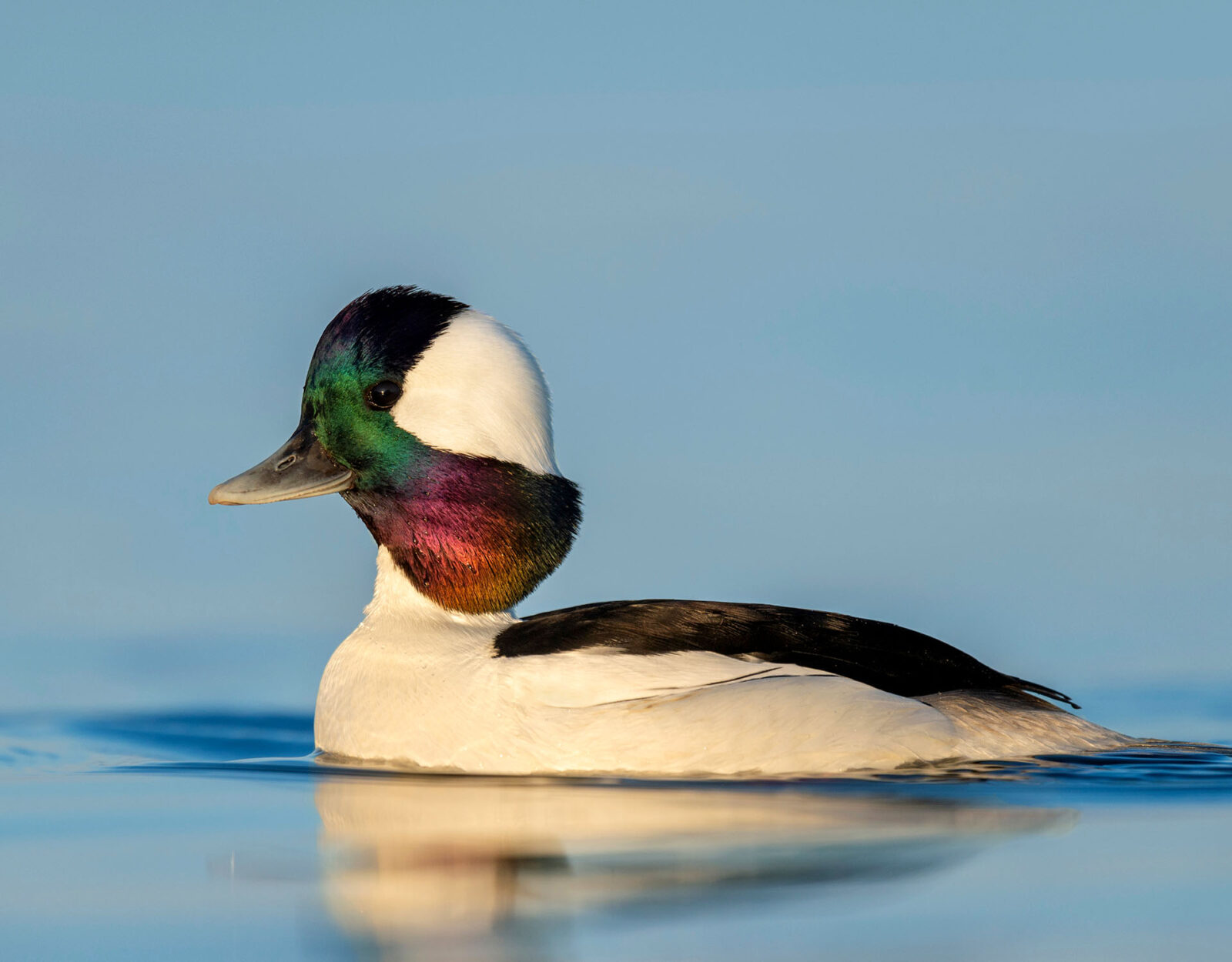
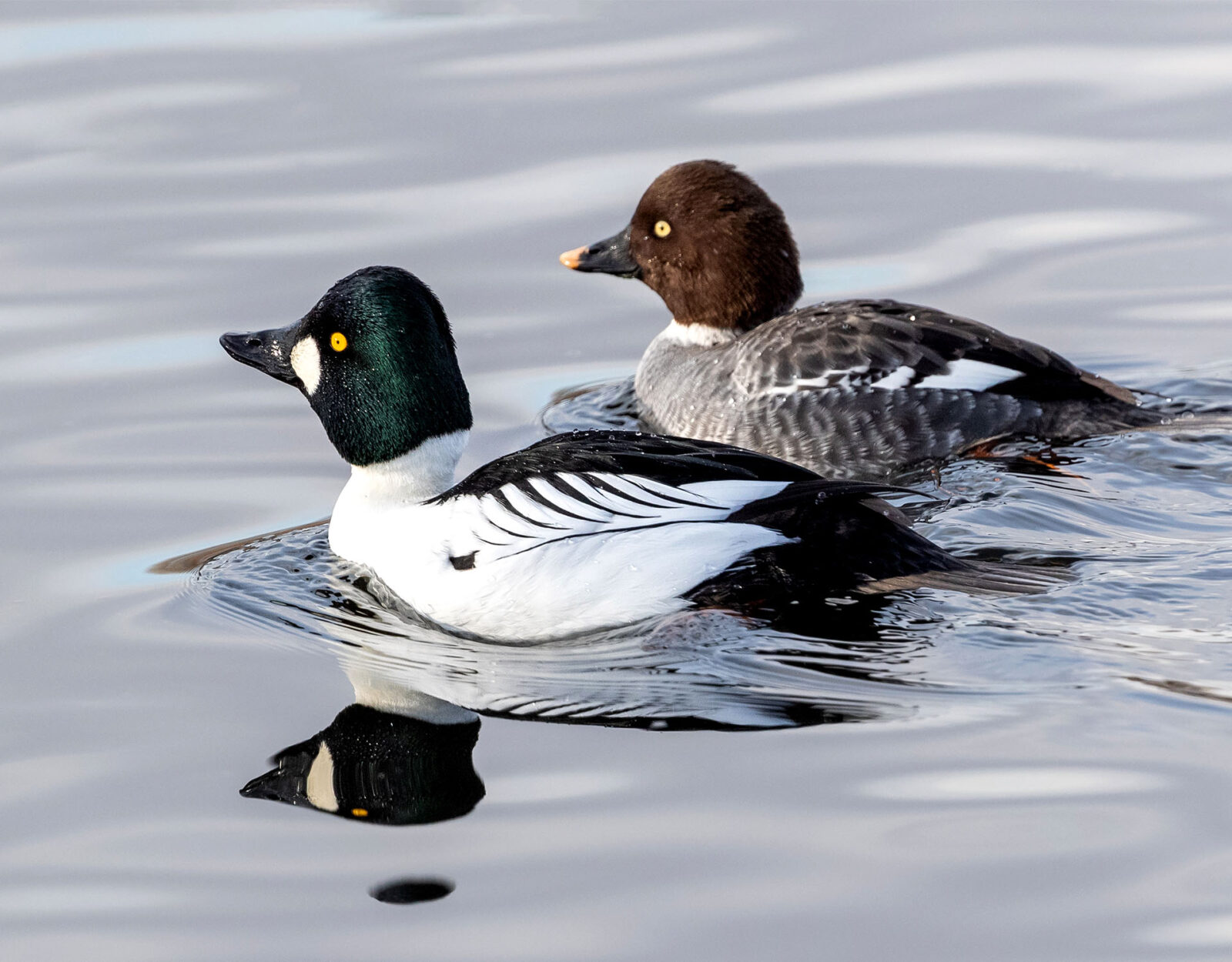
Bufflehead (pictured above left) and goldeneyes (pictured above right) are small-bodied diving ducks best known for their fast, agile flight and striking plumage. Though not often the focus of most hunts, they are a welcome addition to diver spreads and are commonly encountered during the season.
Bufflehead are the smallest diving duck in North America, often flying in pairs or small flocks. Drakes feature a bold white head patch and iridescent plumage, making them highly visible both on the wing and on the water. Goldeneyes—primarily the common goldeneye, with the less frequently seen Barrow’s goldeneye—are larger than bufflehead but still compact and quick. Males are known for their crisp black-and-white contrast, greenish or purplish heads, and piercing yellow eyes that give the species its name.
Both are fast and maneuverable in flight and are generally less responsive to calling than more social divers such as scaup or redheads.
Bufflehead and Goldeneyes Habitat
Bufflehead and goldeneyes are adapted to cold-weather open water habitats and are common in northern latitudes during fall migration, as well as throughout the southern U.S. during winter. They occupy clear lakes, riverine backwaters, oxbows, and coastal estuaries, often favoring sheltered coves and shorelines with minimal disturbance.
Bufflehead are unique among divers in that they are cavity nesters, using abandoned woodpecker holes—especially those made by northern flickers—in small aspen or poplar trees near fishless ponds. During migration and winter, they rely on invertebrate-rich waters where they dive for insects, snails, and small crustaceans.
Goldeneyes are also cavity nesters and breed commonly in the boreal forests of Canada and the northern United States. They use larger tree cavities or nest boxes near lakes and rivers. In winter, common goldeneyes concentrate along large rivers, reservoirs, and brackish bays, often diving for mollusks and crustaceans in deeper water than bufflehead.
In the Lower Mississippi Valley and Deep South, both species can be found on aquaculture ponds, barrow pits, reservoirs, and oxbows—especially late in the season when other wetlands begin to freeze or when hunting pressure pushes birds from shallower, more crowded areas.
Bufflehead and Goldeneyes Hunting Tactics
While not typically the target of dedicated hunts, both bufflehead and goldeneyes will decoy under the right conditions, particularly in open-water setups with low pressure and realistic motion. To improve your chances, add a small number of bufflehead or goldeneye decoys near diver spreads, keeping spacing natural and open. Focus on locations where birds are actively feeding or loafing. Positioning along coves, points, or the sheltered edges of lakes and rivers can increase visibility and draw in passing flocks.
Ruddy Duck
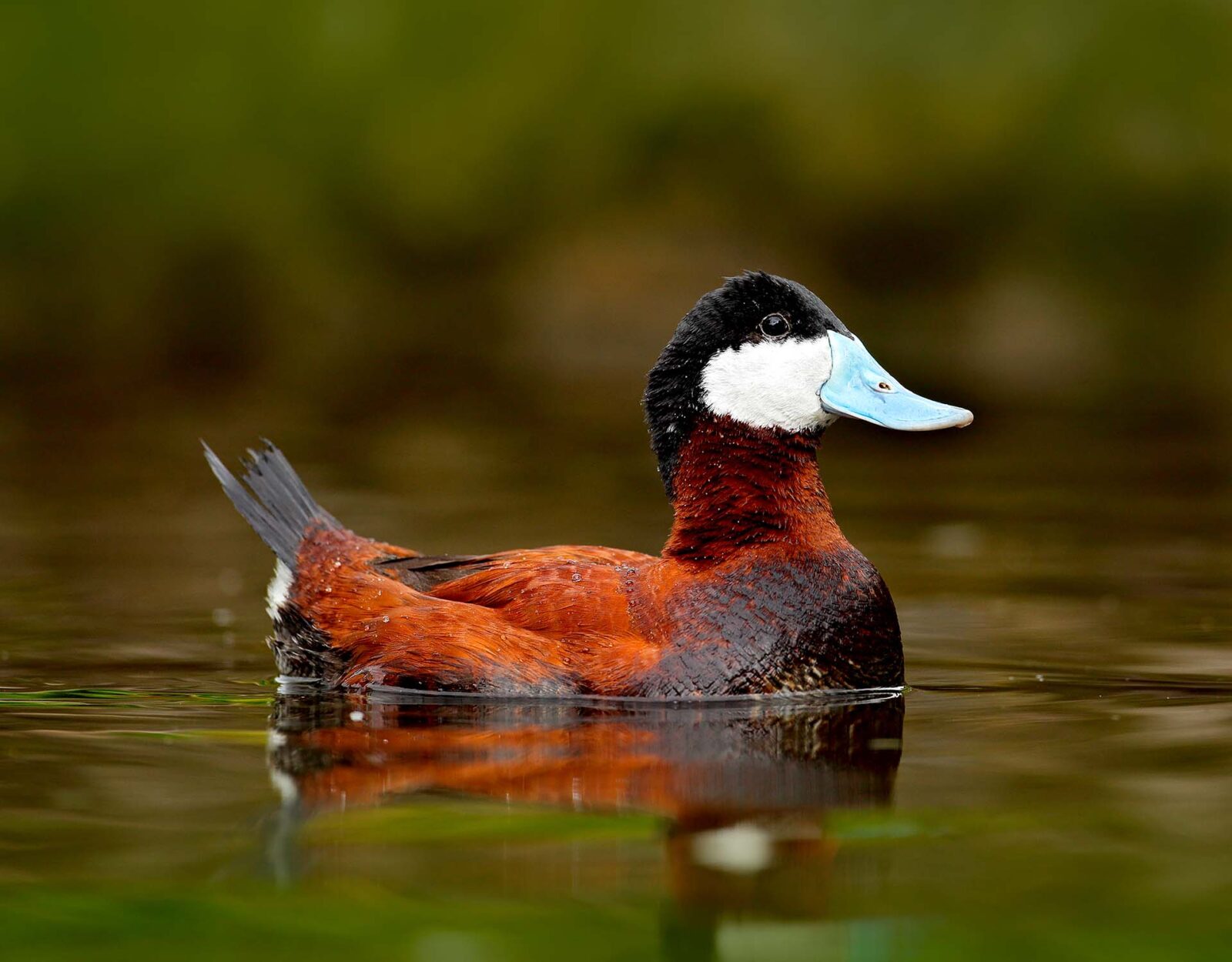
Ruddy ducks are small, thick-necked diving ducks best known for their upright tails and compact profile on the water. While drake ruddies in breeding season sport striking chestnut bodies and powder-blue bills, hunters rarely see them in that plumage.
Ruddies are among the latest-nesting ducks in North America, and most males do not molt into full breeding colors until spring—well after the waterfowl season has ended. During fall and winter, both sexes appear mottled gray-brown with subtle facial markings and a dark crown.
Though not typically a targeted species, ruddy ducks often show up in diver spreads, particularly in the Deep South. They raft in large numbers, dive frequently, and offer fast, low shooting opportunities when they commit.
Ruddy Duck Habitat
Ruddy ducks breed across the Prairie Pothole Region and western North America, favoring small, shallow wetlands with dense emergent vegetation. Nesting peaks in June and July, and broods are often still growing as migration begins.
In winter, ruddy ducks concentrate in deep freshwater wetlands, reservoirs, oxbows, sewage lagoons, and coastal bays—particularly those with abundant submerged aquatic vegetation (SAV) and invertebrates. In the Lower Mississippi Alluvial Valley (LMAV), they are consistently found in catfish aquaculture ponds, where they raft in large numbers throughout the winter. These ponds offer ideal foraging conditions: stable water levels, minimal disturbance, and rich invertebrate communities supported by high nutrient levels and residual feed.
Ruddy Duck Hunting Tactics
Ruddy ducks are not especially responsive to calling or decoys and are best hunted by capitalizing on known movement patterns between roosting and feeding areas. In aquaculture landscapes like the Mississippi Delta, they often move in short flights between adjacent ponds or shift between deeper roosting water and shallow feeding zones. Well-scouted setups on levees, points, or windward edges can provide good pass-shooting opportunities.
When they do decoy, ruddies often approach low and fast, skimming the surface before dropping into the spread. Their small size and dense feathering can make them surprisingly tough to bring down cleanly, so solid shooting fundamentals are essential.
Table Fare and Historical Use
Ruddy ducks have a mixed reputation in the modern kitchen due to their diet—largely aquatic invertebrates and benthic organisms—but they were once considered reliable table fare, particularly in the early 20th century. Market hunters in the western U.S. and California’s Central Valley harvested them in large numbers. When feeding heavily on SAV and seeds, ruddy ducks can offer decent eating, but flavor varies considerably with habitat and location. Today, hunters value ruddy ducks more for their abundance, behavior, and contribution to a mixed bag of divers.